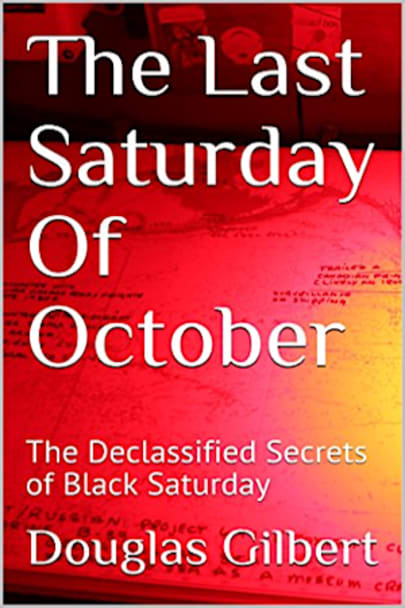The Last Saturday of October: The Declassified Secrets of Black Saturday transports you to the mysterious world of a Russian submarine during the nuclear standoff of 1962. This disturbing historical narrative delivers a true story that will leave you sweating and gasping for breath.Four Russian submarines secretly carried nuclear torpedoes from the Arctic Circle into the Cuban Missile Crisis. … Crisis. Plagued by mission uncertainty and confusing instructions on when to use their weapons, they battled fierce storms and Hurricane Ella to reach the Sargasso Sea where subtropical heat turned their subs into hell holes. When they surfaced to relieve their suffering, they faced the largest antisubmarine force ever assembled in one ocean, waiting to attack them.
This submarine thriller discloses the recently declassified information that chronicles the little-known B-59 incident. It recreates the story of an unsung Russian hero, naval officer Vasili Arkhipov, who intervened to thwart a nuclear attack on the US Navy on the most dangerous day in human history. Ride the Soviet submarine, B-59, from Murmansk to the American naval blockade and experience Black Saturday from inside the hull.
Fans of The Hunt for Red October and Das Boot will enjoy this thrilling and disturbing depiction of naval history on the high seas.
more



The word “thriller” hardly seems adequate to describe a barely fictionalized account of an event that actually occurred at the height of the Cuban Missile Crisis in 1962. Not only is this a pulse-pounding tale of a potentially-catastrophic incident that occurred between two super-powers, it is written from the Russian point of view, something we Americans rarely get to read.
The story follows a brigade of nuclear-armed submarines ordered to Cuba by the Soviet government as part of its nuclear weaponization program. We follow one of these subs, commanded by Valentine Savitsky and captain Vasili Arkipov, from the Russian Arctic south across the Atlantic. Almost immediately the sub runs into trouble at its first dive. Nothing gets any easier after that. The sub and its crew experience North Sea storms and an Atlantic hurricane that nearly does them in. Finally, they arrive in the tropical Sargasso Sea where they are essentially abandoned by Moscow, sent virtually no information, and left to fend for themselves. Their last order is to wait until given the order to proceed to Cuba. After the battering of the hurricane, they are left to languish in the tropics – a hot and humid climate that they and their ship are not prepared to survive, especially when forced to stay deeply submerged for long periods to avoid detection. The suffering of the sailors increases. Lack of oxygen and lack of water lead to various serious ailments – among them dysentery and painful skin diseases as well as extreme exhaustion. Death seems imminent.
Meanwhile, U.S. Navy has set up a blockade to prevent Soviet ships from entering and arming Cuba. A cat-and-mouse game follows between the sub and U.S. Navy ships determined to find it. This is where the drama comes in. The Soviet commander lacks orders from Moscow but is willing to use his nuclear-armed torpedo if war has broken out. He’s a warrior, and he wants to go down fighting. But has war broken out? Captain Arkipov convinces the commander that there is no sure sign of war, that the Americans appear only to be using sonobuoys for detection, not destruction, and a single ping from the sub might bring about an American stand down. That’s what the Russians do in the end. It works. In short, Arkipov manages to prevent the outbreak of World War III. Eventually the Soviet sub is detected and forced to surface. One of the lighter moments was learning that when the sub came up for air and to charge batteries, the Russian crew found itself surrounded by U.S. Navy destroyers shining bright lights on their sub and blasting out Dixieland jazz music in their direction. As they were in international waters and no conflict was imminent, the Americans let the Soviet sub go back out to sea.
My only critique of The Last Saturday of October is that it needed the thoughtful touch of a skilled editor. The book sometimes falls into deep weeds with its detailed descriptions of submarine construction, technology and culture that could cause crossed-eyes in the general reader. Also an editor would have caught and revised some inauthentic dialog and phrases that were nonsensical. Also problematic is the appearance of undefined naval and submarine terms that are unfamiliar to the general reader. An example is “piss cutter.” Look in your UrbanDictionary.com for that one.
After graduating from the U.S. Naval Academy and serving as a naval officer, author Douglas Gilbert spent his subsequent career in electrical engineering working on sonar detection systems in submarines and surface ships. He is imminently well-qualified to present this very well-researched account of a not well-known historical event. The book has photos, a detailed annotated bibliography, and glossaries. Word of advice to author: Find an agent who can sell this to Hollywood before some far-less qualified screen writer discovers the story. Last Saturday will make a great film.
Fascinating piece of unknown history. Reads like a thriller.
If you believe you know about the Cuban Missile Crisis, I bet you don’t know as much as you think. A work of historical fiction based on recently declassified secret documents that is truly a fantastic read. Did you know that one Russian submariner probably single-handedly saved the world from nuclear war?